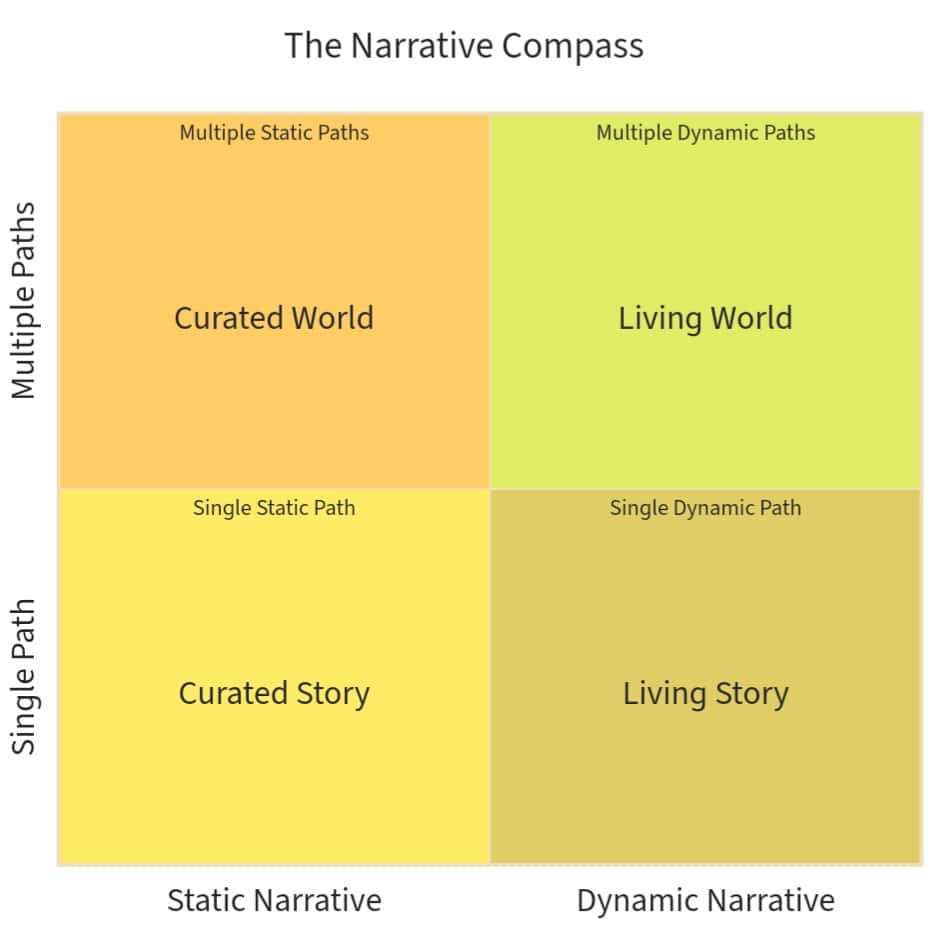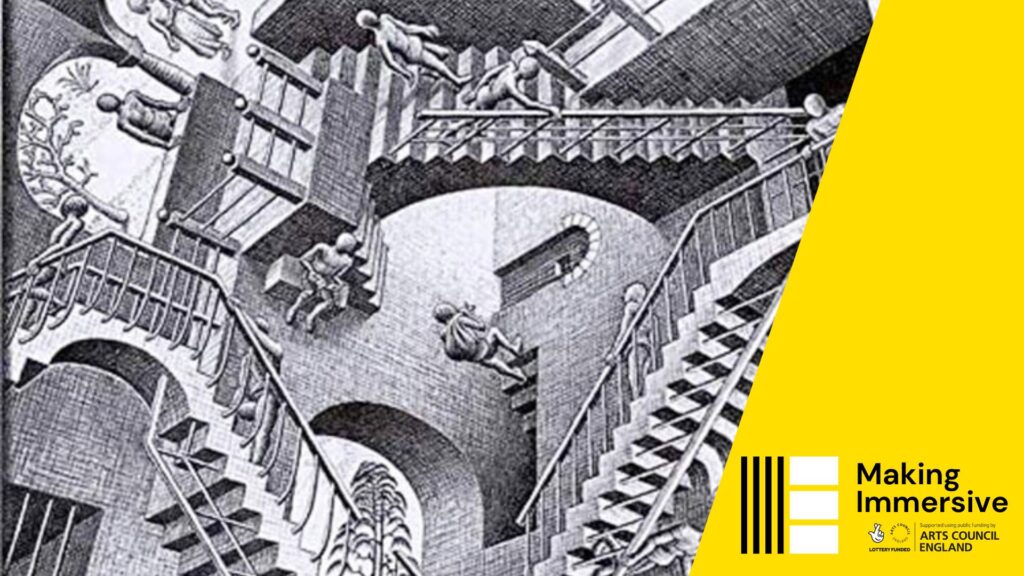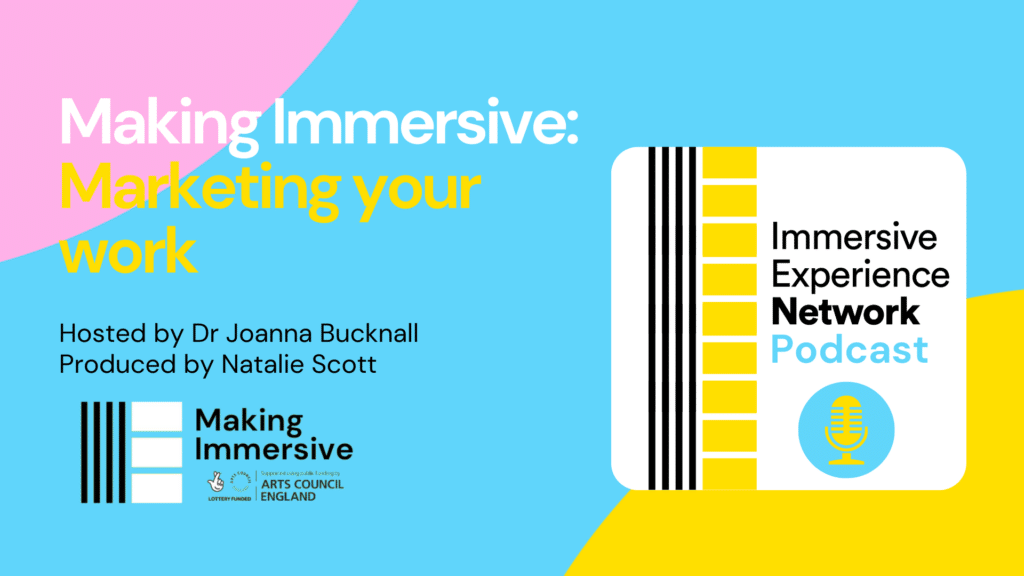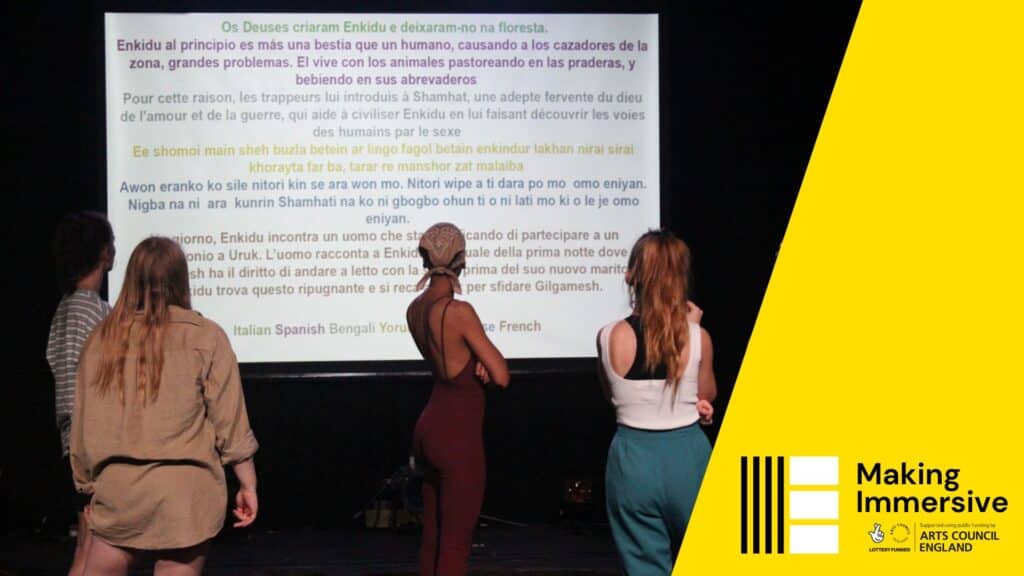Immersive performances can tell stories in ways that more established forms can’t replicate. We can give different audience members different experiences, and open windows with multiple perspectives. We can also, very easily, completely obliterate our ability to think straight by underestimating the complexity of these forms. Here’s one attempt to show how we can think about, plan and choose different narrative forms.
Describing Immersive Stories
It’s clearly impossible to neatly categorise stories in any meaningful way, so I’m going to use two scales that distinguish immersive narratives from other theatrical forms. They’re focussed on what the audience experiences rather than any kind of artistic process, and we can briefly summarise the strengths and challenges they highlight.
Paths: Single Vs Multiple
By paths, I’m referring to how much freedom to “roam” the audience is given. This is a slightly loose term, because the choices the audience are offered don’t have to refer to a huge amount of physical space. In a narrative sense, choosing to speak to the old man sitting alone at the bar rather than the harried-looking bartender is just as impactful as deciding which room to enter.
The ability to explore freely is, obviously, attractive, but the big implication here is about the significant resources that are required. We have to work out…
…Rehearsal times
…How to make sure each path is equally fulfilling
…The number of performers
…Costs of using multiple spaces
Reactivity: Static Vs Dynamic
If paths dictate whether the audience can choose what they go, this scale asks if they can choose where the story goes. Does a different narrative play out based on audience actions, or is there a set route that the narrative will follow? The appeal of a story reacting to the audience is obvious, but there are some new challenges to consider too. How do we…
…Keep track of the correct changes during a run?
…Signal the moments that the audience can influence?
…Rehearse a changing story?
The Exponential Problems of Choice
Before we dive into the different forms, take a look at this chart.
3 Choices, 15 Scenes

It’s a simplified version of what can happen if you create multiple paths, or allow real dynamism, without thinking through the consequences.
We can mitigate this a little with some clever story-weaving.
3 Choices, 10 Scenes

If you’re looking for advice on constructing branching storylines, get yourself lost in the interactive fiction community. They’ve been thinking about narrative responsiveness since the early days of computers and, with a little translation into theatre, there’s a wealth of help. I would recommend starting with Standard Patterns in Choice-Based Games by Sam Kabo Ashwell. I promise it’s a lot more interesting than the title might suggest.
Combinations: Four Broad Forms of Story
For a moment, let’s pretend that these are two binary choices rather than a whole load of blurred panic. We’ll say that your narrative is either static or dynamic, and that it can be experienced in a single way or multiple ways.
What this gives us is four broad categories of narrative that a production can fall under. Whilst it’s very rare for things to happen this cleanly in the real world, it’s still a very useful way of thinking about immersive work. Here, I’ve made this handy diagram to make things a little clearer.

Immersive Theatre is still a young discipline, so we haven’t yet settled on the language we use to talk about it. Let’s look at each of them in more detail.
Curated Stories: A Single Static Path
Early explorations of immersive performance blur into Promenade Theatre. I won’t go into detail here as this is narratively no different to other forms of theatre, but it’s worth mentioning that this way of doing things carries a major strength: total curation of the audience experience. Allowing the audience to sink into the receptive mode, making no huge choices, means they can devote their minds to receiving all the weight and themes of a story.
Living Stories: A Single Dynamic Path
This is actually a fairly rare form; a show where all the audience experience the same path, but the aggregated choices they make change the story. Some of the very earliest protoimmersivework did this, and I saw some fascinating pieces in the wake of Brexit that used voting as a mechanism.
It can be a useful way to explore an audience’s relationship to each other, and I thoroughly recommend exploring the work of Jamie Harper if you’re interested in playing with the form like this.
Curated Worlds: Multiple Static Paths
This is probably the form that leaps to mind when most people think about Immersive Theatre. It’s the format popularised by Punchdrunk, and there’s a good chance that you can currently buy a ticket to this type of production right now.
In a Living Story, the audience are given freedom to follow whichever threads grab their interest. The narrative isn’t going to change, but how you experience it can vary significantly. Done well, this can lead to excited conversation between audience members as they compare notes and piece together the story.
“I lost sight of you after that yellow monkey stole the necklace from the flower seller! She never recovered, I felt so bad for her.”
“Well, I followed the yellow monkey back to his house, and it turns out that the flower seller had actually stolen that necklace back in 1995.”
There are two main challenges here. One is that the audience can become lost; without planning, it’s possible for their experience to consist mainly of constantly missing the interesting moments. Some thought needs to be given towards creating “signposts” for the audience. We’re looking for subtle ways of indicating that, whilst they can go anywhere they like, it might be slightly more enjoyable if they go in certain directions.
The other problem is that you need to build in some very robust ways of keeping different story paths synchronised. How do actors know when to start a particular scene? What happens if a particular moment is taking longer than usual because an audience member needed longer to move through the space?
Remember, there are rehearsal time considerations too. Some creative techniques are required unless you want to double your rehearsal time every time a choice of narrative path is offered.
Living Worlds: Multiple Dynamic Paths
It is very, very rare to see a show that truly belongs in this category across its whole length. Imagine all the challenges from the previous two categories, and multiply them exponentially. I don’t have much concrete advice to give you, as this is untested territory.
There are, however, ways to create a sense of organic, responsive freedom in your narrative.
For example, you can treat any individual path in your multiple path production as being a self-contained dynamic story. Choices made by the audience within that path can echo across, and reshape, future beats in the same path. As long as the overarching narrative that stretches across the whole play can proceed unhindered, this shouldn’t cause any problems.
Main Narrative: Two angry young french nobles are on their way to fight a duel.
Side Narrative: The audience following one of the duellists encourages him to confess his sins before fighting. On another night, he didn’t repent.
Another way of creating a dynamism to the story is to create specific moments where a choice can have repercussions that echo down the play. The challenge is figuring out how to let the audience know when these moments are.
Let’s finish with some realism; if you’re into immersive, you probably read all my warnings about spiralling complexity and thought to yourself “bring it on”. So I’ll leave you with one final bit of advice.
Whatever you do, commit to it. When the narrative is static, lean into that rather than peppering it with meaningless fluff choices… and when you’re offering multiple paths, make certain they matter.
Wait, no, this is the final bit of advice. Steal liberally from entertainment forms older than ours. Interactive fiction writers, street artists, gamebook authors, LARP players… find them, buy them a drink, be respectful and go make something no one else has thought of.






